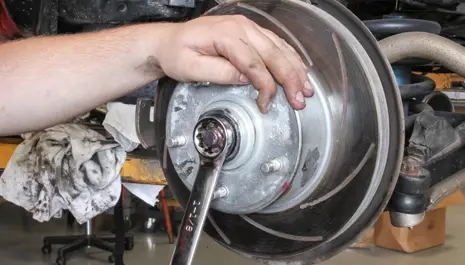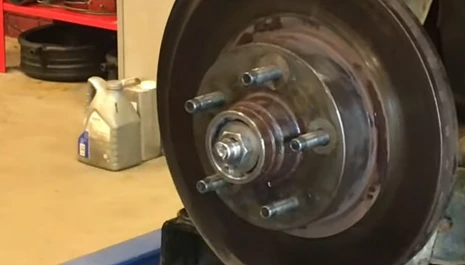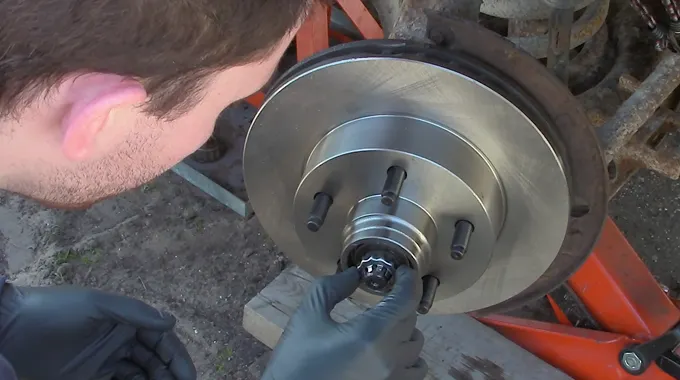Last Updated on February 28, 2023
You would be amazed at how many people don’t know a way to tighten wheel bearing. It’s a common problem that can affect anyone, but it is often the case for people who aren’t mechanically inclined. Luckily, you can take some simple steps to get your bearings tightened and back on the road in no time.
In this article, we’re going to show you how to tighten wheel bearings on a car. So, if you’re having trouble with your bearings, read on for some helpful tips.
What are Wheel Bearings, And What Do They Do?
Wheel bearings are a component of your car’s wheel assembly. They are responsible for keeping the wheel spinning smoothly and quietly. Wheel bearings are typically made of metal and are contained within a sealed housing. They can be lubricated with grease or oil to help keep them in good condition.
How Do I Know If My Wheel Bearings Need Tightening?

There are several signs that your wheel bearings may need tightening. If you experience any of the following symptoms, your bearings likely need some attention:
- Uneven tire wear
- Grinding or rattling noise when the car is in motion
- Car pulling to one side when driving
If you notice any of these symptoms, it’s essential to have your bearings checked as soon as possible.
A Step-by-Step Guide: How to Tighten Wheel Bearings?
There are a few simple steps you can take to tighten your wheel bearings. Here’s what you need to do:
1. Jack up Your Car and Remove the Wheel
Before you can work on your bad wheel bearing, you’ll need to jack up your car and remove the wheel. There are a few different ways to do this, so consult your car’s owner’s manual for specific instructions.
2. Remove the Bearing Cap
The bearing cap is the cover that protects the bearings. It is typically held in place with several bolts. Use a wrench to remove the bolts and set the lid aside.
3. Clean and Inspect the Bearings
Now that you have access to the bearings, it’s essential to clean and inspect them. Use a brush or rag to remove any dirt or debris present. Inspect the bearings for signs of wear or damage. If the approaches look damaged, they will need to be replaced.
4. Adjust the Bearings
Once you’ve inspected the bearings, you can begin to adjust them. To do this, turn the adjusting nut until the bearing is tight. You may need to use a wrench to hold the bearing in place while you turn the nut.
5. Replace the Bearing Cap
Once the bearings have been appropriately adjusted, you can replace the bearing cap. Be sure to use new bolts to secure the cap in place.
6. Repetition on the Other Side
Repeat the process on the other side of the car. Commonly, bearings will need to be adjusted on both the front and rear wheels.
7. Lower Your Car and Replace the Wheel
Lower your car and replace the wheel once you’ve adjusted all of the bearings. Be sure to tighten the lug nuts firmly. This will help keep the wheel in place while you drive.
8. Test Your Car
Once you’ve completed all of the steps, it’s time to test your car. Be sure to watch out for any abnormal noise or vibration. If everything seems to be working correctly, you’re good to go!
What are The Consequences of Not Tightening Wheel Bearings?

If you don’t tighten your wheel bearings, several consequences may occur. Here are some of the most common problems that can happen:
- The wheel may come loose from the car while you’re driving.
- The bearings may become damaged and need to be replaced.
- Your car may make a loud noise or vibrate while you’re driving.
It’s important to have your wheel bearings tightened on a regular basis to avoid any of these problems.
What Are The Common Problems With Wheel Bearings?
There are a few common problems that can occur with wheel bearings. Here are some of the most common issues and how to fix them:
The Bearings Are Loose
If the bearings are loose, you’ll need to adjust them as described in the previous section.
Damaged Bearings
If the bearings are damaged, they will need to be replaced. Otherwise, they may cause problems with your car’s performance.
The Bearings Are Too Tight
If the bearings are too tight, you’ll need to loosen them as described in the previous section.
The Wheel Is Wobbling
If the wheel is wobbling, it may be because the bearings are loose or damaged. You’ll need to adjust or replace the bearings as necessary.
The Car Is Pulling To One Side
If the car is pulling to one side, it may be because the bearings are loose or damaged. You’ll need to adjust or replace the bearings as necessary.
FAQs
How Often Should I Tighten My Wheel Bearings?
It’s generally recommended to tighten your wheel bearings every few months. However, it’s a good idea to check them on a regular basis to make sure they’re not loose.
How Tight Should Car Wheel Bearings Be?
In order to meet the requirements of this page, truck wheel bearings have to be able to accept a tolerable end-play of 0.025 mm to 0.127 mm, also expressed as 1 to 5 mils or 1 to 5 mils. It is entirely acceptable to adjust the wheel bearings after they have been installed if there is just a little bit of play, but not too much.
What Happens If You Over-Tighten The Axle Nut?
If you over-tighten the axle nut, you may damage the wheel bearings. It’s important to be careful when adjusting the bearings and to use the correct amount of torque.
Conclusion
Now that you know how to tighten your wheel bearings, you can avoid any of the common problems that can occur. Be sure to adjust them regularly and use the correct amount of torque to ensure they’re correctly tightened. Taking your car for a test drive after drawing the bearings will help you make sure everything is working correctly.

